
Provence Wines
The historical home of French vines, the Provençal vineyard is none other than the first vineyard in the history of France. Indeed, nearly three millennia ago, the Phocaeans built the city of...Read More

In stock. Available for pick-up at store

In stock. Available for pick-up at store

In stock. Available for pick-up at store

In stock. Available for pick-up at store

In stock. Available for pick-up at store
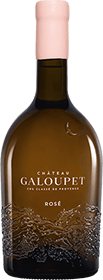
In stock. Available for pick-up at store

In stock. Available for pick-up at store

In stock. Available for pick-up at store

In stock. Available for pick-up at store

In stock. Available for pick-up at store

In stock. Available for pick-up at store

In stock. Available for pick-up at store

In stock. Available for pick-up at store

In stock. Available for pick-up at store

In stock. Available for pick-up at store

In stock. Available for pick-up at store

In-Stock
The Provence Wine Region: Birthplace of French Rosé
Basking ceaselessly in warm rays of Mediterranean sunshine and kept healthy and dry by the Mistral wind that sweeps through this picture-perfect region, the vines of Provence produce a wide range of wines that smell and feel like summer in the glass. Over 30 different varieties of red and white grapes thrive in Provence’s nooks and crannies, in the mosaic of microterroirs that characterize this fascinating and ancient wine region.
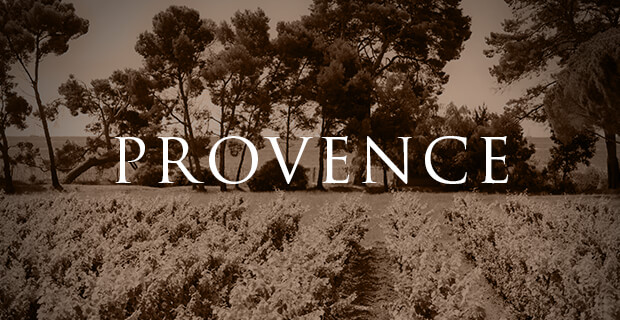
Indulge in a floral, herbaceous and full-bodied Coteaux d’Aix-en-Provence white or an earthy, spicy, age-worthy Mourvedre from the beloved Bandol appellation. And for a poolside barbecue or plate of sushi at virtually any time of the year, you can’t go wrong with a Provence classic: a pale salmon pink or onion skin orange rosé bursting with fresh red fruit and citrus.
Twenty-Six Centuries of Provence Wine Making
While the exact date of the birth of viticulture in Provence is not known, archaeological evidence indicates that the Phocaean Greeks began producing wine here soon after settling in this area in around 600 BC. Fragments of amphorae used to contain wine have been found especially around the city of Marseille, formerly the capital of the Greek colony known as Massalia. This makes Provence the oldest winemaking region of France.
By the time the Romans arrived in this region in 125 BC, the wines from Massalia had already earned a reputation for high quality. These Provence wines are believed to have been an early version of today’s Provence rosé, as they were “pink wines” produced with a very short press, resulting in a pale color. Immediately recognizing the potential of this fertile land, the Romans decided to build upon the existent wine culture, choosing Aix-en-Provence (which they called Aquae Sextiae) as the capital of their province (which they called “Nostra Provincia” or “Our Province”). The Romans greatly influenced the landscape of Provence, introducing amphitheaters, temples and aqueducts to the region.
When the Roman Empire began to fall in the 5th century AD, the Christians arrived and began constructing abbeys, which were placed in charge of the land. During the 14th century, the Roman Catholic Papacy moved its headquarters to Avignon, when in 1309 Pope Clement V chose to establish his court here rather than in Rome. For the next 70 years, Avignon became one of the intellectual and artistic epicenters of the Mediterranean. Winemaking flourished during this time, with local abbeys producing and selling their wine until the 14th century, at which point the region’s great noble families took over.
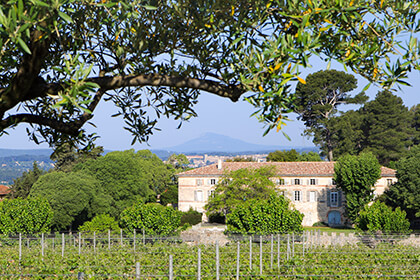
Winemaking in Provence continued throughout the centuries up until the phylloxera epidemic at the end of the 19th century. The parasite destroyed almost all of the vineyards of Provence and the winemakers were faced with the arduous task of grafting the French vines onto American rootstock. Many of the vineyards were replanted to high-yielding but low-quality Carignan grapes during this time. Nevertheless, in the early 20th century, Provence winemaking experienced a quality revolution when local winemakers began to collaborate to form cooperatives. Together, these winemakers began to define the growing and production conditions that would yield the best wines. In 1977 the AOC Cotes de Provence was born, followed by AOC Coteaux d’Aix-en-Provence in 1985 and Coteaux Varois en Provence in 1993.
The arrival of tourism on the French Riviera also helped boost local winemaking in Provence and contributed significantly to the international reputation of its flagship style, now known and beloved around the world: the Provencal rosé.
Provence Wine from a Mediterranean Terroir
The region of Provence is situated on the Mediterranean coast in the southeastern corner of France. Roughly 200 kilometers (or 125 miles) wide from east to west and around 160 kilometers (100 miles) long, Provence is bordered to the east by the Cote d’Azur and to the west by the Rhone River.
Perhaps the defining aspect of the Provence terroir is its distinctly Mediterranean climate. The vines here bask in sunshine all year long, with the region boasting 2700-3000 hours of annual sunshine and an average annual temperature of 58°F (14.5°C). The nearby Mediterranean Sea helps moderate the temperature, while the cool Mistral wind blowing down from the north along the Rhone River dries out the area and helps keep the vines free of pests and disease. The Mistral also helps cool the grapes, allowing them to preserve their natural acidity. Nevertheless, the Mistral and other strong winds can also severely damage vines that are not securely trained or protected. This explains why many of the best vineyards in Provence are planted on gently sloping hillsides and sheltered valleys.
The summers in Provence are long and dry, providing fantastic conditions for the harvest of beautiful and ripe grapes. Storms in the spring and fall contribute to an average annual rainfall of 760 mm (or 30 inches). This arid, hilly landscape is also home to a plethora of wild vegetation and plant life, including shrubs, woodlands and the famous “Herbes de Provence” (Provencal herbs) used in the region’s recipes. This fauna is commonly referred to as “garrigue” and it contributes organic matter to the soil, while also lending a certain herbaceous touch to the wines of Provence.
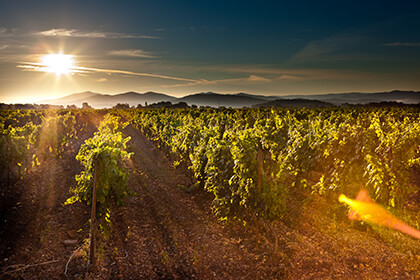
Provence is home to a very wide array of soil types, ranging from limestone and shale in the AOC Cassis to the west and near the coastline to schist and quartz in other coastal areas. More inland, you’ll find a combination of clay and sandstone.
The dazzling array of microterroirs created by this vast variety of soil types, slopes and valleys translates into a wide range of grape varieties planted in Provence. The more successful local varieties include Tibouren and Vermentino (which is locally known as Rolle), Ugni Blanc (or Trebbiano), Bourboulence, Clairette, Marsanne, Rousanne and Grenache Blanc for the whites and Mourvedre, Carignan, Cinsault, Counise and Tannat for the reds. The region is also home to many Grenache, Syrah and Cabernet Sauvignon vines which thrive in Provence’s Mediterranean climate. Altogether, around 36 grape varieties are allowed in Provence.
While 88% of Provence’s wine production is dedicated to rosé (a French wine we all know and love), Provence also produces some equally stunning red wines and white wines as well.
The Appellations of Provence Wine and Their Signature Styles
In total, the Provence wine region is home to nine wine-producing appellations.
By far the largest and most common appellation is Cotes de Provence, running along the Rhone River in the eastern half of Provence and spanning three departments (Var, Bouches-du-Rhone and a village in Alpes-Maritimes). Recognized as an AOC in 1977, this appellation covers just over 20,000 hectares (50,000 acres) of vineyards and produces the great majority of Provence’s rosé wines. In fact, rosé accounts for almost 90% of the production of Cotes de Rhone, and is typically made from Grenache, Syrah, Mourvedre, Cinsault, Carignan and Tibouren. Around 6.5% of the wines from Cotes de Provence are red, made from the Grenache, Syrah, Mourvedre, Cinsault, Carignan and Cabernet Sauvignon. The remaining 3.5% is white, mostly made from Rolle (the local name for Vermentino), as well as Ugni Blanc, Clairette and Semillon. Some of the most famous producers of Provence are situated in Cotes de Provence, including Miraval, Minuty, Domaines Ott, Caves d’Esclans and Peyrassol.
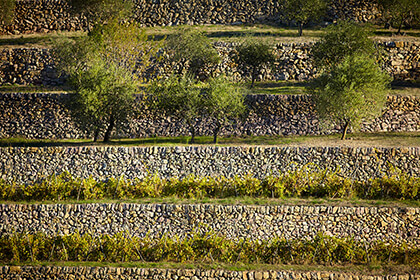
Cotes de Provence comprises a wide range of different soils types, mostly calcareous to the north and west and crystalline to the south and east. The appellation is home to four distinct terroir designations: Côtes de Provence Sainte-Victoire (home to Château Coussin, for example), Côtes de Provence Fréjus, Côtes de Provence La Londe (home to Sainte Marguerite en Provence) and Côtes de Provence Pierrefeu. Cotes de Provence rosés tend to display a pale pink color in the glass, with aromas of citrus fruit (lemon and grapefruit), exotic fruit (mango and passion fruit), and red fruit (raspberry, strawberry, cherry and redcurrant) blending with floral fragrances, like hawthorn, white flowers and fennel. At the tasting, the red wines from here show cherry, raspberry, blackcurrant and strawberry aromas on the nose and very smooth, well-rounded tannins on the palate. The whites reveal gorgeous pear and exotic fruit aromas, as well as citrus and herbs (sage and mint). These whites are very generous on the palate, without ever becoming too heavy.
The second largest appellation of Provence is Coteaux d’Aix-en-Provence, situated in the far west of the region. Here, the soils can be divided into stony clay and limestone, gravelly and sandy soil on sandstone and molasse or stony soil with clay. Around 82% of the production of Coteaux d’Aix-en-Provence is rosé, complemented by 12% red and 5.5% white wine. At the tasting, the rosés offer delicious red fruit, peach and citrus aromas, as well as a fresh and sometimes mineral finish, such as those of Chateau Pigoudet. The red wines of Coteaux d’Aix-en-Provence, such as those of Villa Baulieu, reveal red and dark fruit as well as a certain spicy touch of pepper and licorice. The whites are intense on the nose and very fresh on the palate, with notes of lemon and exotic fruit shining through.
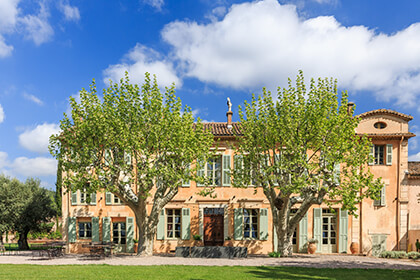
The vineyards of the Coteaux Varois en Provence appellation are situated in the Var department in the “heart of Provence” and they grow at an average altitude of 350 meters (with some plots as high up as 500 meters) on the hills and valleys of a limestone mountain range. The climate of Coteaux Varois en Provence is continental with very hot summers and colder, harsher winters than in the rest of the Provence region. This appellation produces 90% rosé wines, 7% red wines and 3% whites. The rosés are very complex and expressive, revealing fresh citrus fruit with white and yellow-fleshed stone fruit. The reds show dark fruit, spices and touches of leather, while the whites express citrus, white fruit and white floral fragrances.
To the west of the appellation lies the hilltop village of Les Baux-de-Provence, characterized by one of the hottest climates in Provence. The vines here grow in the inhospitable and rugged terrain of the Alpilles hillsides and produce high-quality wines that are usually either organic or biodynamic. Les Baux-de-Provence produces mostly red wines, as well as some rosé wines from Grenache, Syrah and Mourvedre.
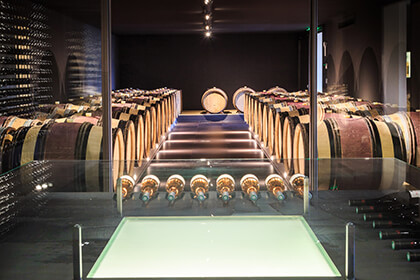
One of the most unique styles of Provence comes from the appellation of Bandol, best known for producing beautifully spicy, oaky red wines and dry rosés from Mourvedre (the appellation’s flagship variety), sometimes blended with Cinsault and Grenache. This is one of the few wine regions in the world where late-ripening Mourvedre thrives, as the amphitheater of terraced vineyards are characterized by a very warm climate and are protected from the harsh Mistral winds. The red wines of Bandol are luscious and ripe, with fantastic aging potential, while the Bandol rosé wines are spicy and earthy, considered some of the best in France.
Situated along the coast, Cassis is the white equivalent to Bandol, producing extremely elegant and intense dry white wines from Marsanne and Clairette. Palette is the smallest of the Provence AOCs produces red and rose wines from a wide range of grape varieties (but predominantly from Mourvedre), which are then mandatorily aged for 18 months in oak. From steep hillsides surrounding the city of Nice in the far eastern part of Provence is Bellet, producing red and rosé wines from Braquet and Folle Noir, with the rosé wines known for their distinctive rose petal fragrances. And the most northerly of Provence’s AOX appellations is Pierrevert in the Alpes de Haute Provence, producing red blends from Grenache, Syrah, Cinsault and Carignan as well as whites from Grenache Blanc, Rolle, Marsanne and Roussanne.
How to Enjoy a Provence Wine
The classic wine of Provence is a light, dry rosé with a pink hue that ranges from pale salmon to very light pink, to a deep, peachy pink and even onion-skin orange tones. Provence rosés are an absolute must-have for the summer season, the perfect choice to enjoy under the sunshine. Enjoy them pool-side or with a food pairing at your next barbecue. These wines go beautifully with most light summer dishes, including salmon, fresh seafood and shellfish, roast chicken and grilled vegetables. While they shine brightest in the summertime, Provence rosés are fantastic all year round, excellent for aperitifs or get-togethers with friends. These wines should always be served chilled.
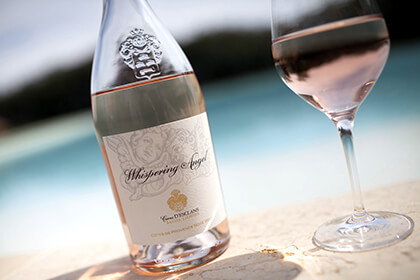
The red wines of Provence are fantastic to pair with grilled or braised meats. Some of these wines have a certain meaty, mushroomy, earthy aromas reminiscent of the famous Provence garrigue, while others are more fruit-forward, revealing red and black fruits and some minerality from the soil. The red wines of Bandol are particularly prized by wine lovers as one of the greatest expressions of the luscious, black-fruit-jammy Mourvedre grape in the world. Pair a Bandol red, like those of Domaine de la Begude, with gamey meats like a beefy stew or venison.
And finally, pair Provence whites (like those of the fabulous Cassis AOC) with seafood and shellfish, or roast chicken with vegetables.